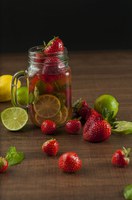Prairie Fare: Stay Hydrated During Warm Summer Months
(Click an image below to view a high-resolution image that can be downloaded)
By Julie Garden-Robinson, Food and Nutrition Specialist
NDSU Extension
Like many people, I have been busy with yardwork lately.
We have had a proliferation of miniature maple trees popping up all over our yard, thanks to hundreds (maybe thousands) of propellerlike seeds dropping from our tree.
I wander around the yard every day, inspecting my pots and gardens for the telltale reddish stems and pointed leaves. Other than preventing a maple tree forest from sprouting in my yard, I really don’t need to check my plants several times per day.
However, I love to watch plants grow and flourish with sunny days and regular rain. Sometimes, I almost catch my tomatoes growing before my eyes. OK, maybe my imagination is a bit overactive.
We need to stay nourished and hydrated just like plants, especially when we work or play outside in the heat. Along with staying hydrated, be sure to wear a hat that protects your ears and neck, and SPF 30 sunscreen when you’re in the sun.
Dehydration can be serious. We need to maintain our hydration level to help regulate processes such as body temperature and waste removal, and carry nutrients and oxygen. We mainly lose water through perspiration, exhaling and urination.
Symptoms of dehydration include nausea, sunken eyes, muscle cramps, clammy skin and rapid heartbeat. If you suspect you and/or someone under your care are dehydrated, contact a health-care provider immediately.
Children, older adults and outdoor workers are especially vulnerable to dehydration. Illness, medications and age can affect water needs. When playing or working outside in warm weather, taking fluid breaks regularly is a good idea.
How do you quench your thirst? Do you reach for a soda, lemonade, iced coffee or something else? We have a lot of choices available in the beverage category.
Soft drink consumption has increased five times since the late 1960s. Kids are having sweetened soft drinks at younger ages, and the portion sizes of fountain drinks have increased drastically.
Watch out for these “liquid calories” that provide few, if any, nutrients. Fruit-flavored beverages (punch, lemonade, fruit-flavored drinks), sweet tea, sports drinks and “regular” (not diet) soda contain added sweeteners and calories without nutrients.
Scientists have named sweetened beverages one of the issues linked with higher obesity rates, which can increase our risk for chronic diseases, including diabetes, heart disease and cancer. Sweetened beverages can promote dental decay. In fact, while diet soft drinks do not have calories, the acid they contain is tough on teeth.
One 12-ounce can of cola has about 10 teaspoons of sugar (as high-fructose corn syrup) and 150 calories. Cutting out one can of sweetened soda daily (and not consuming the calories in another way) could result in a 15-pound weight loss in a year.
Along with choosing healthful beverage options, how much fluids do you need per day? The answer is, “It depends.”
According to research, healthy people usually can use thirst to gauge their needs. The fluid intake of athletes, older adults, young children and people with medical conditions may need to be monitored more closely. On average, we need 8 or more total cups of fluids per day from foods and beverages.
For nutrition and hydration, enjoy more fruits and vegetables. Aim for at least 4 1/2 cups of fruits and vegetables daily. On average, fruits and vegetables are at least 85 percent water by weight.
Consider these tips as you enjoy the summer season.
- Quench your thirst with water. Most kids do not need sports drinks to quench their thirst.
- Make water, low-fat or fat-free milk or 100 percent juice options in your home. However, encourage family members to eat whole fruit more often than they drink fruit juice for the fiber advantage.
- Take water on the go in a reusable water bottle. If you are purchasing a water bottle, look for one without a lot of crevices that are hard to clean. Reusable water bottles are easy on the environment, convenient and cost-effective. Wash water bottles thoroughly between uses. If your water bottle is dishwasher-safe, run it through the cleaning and sanitizing cycle.
- Save money at restaurants by ordering water when dining out and drinking water from the tap at home.
- Enjoy an occasional sweetened beverage but have a smaller portion. Split a can of soda pop or try the smaller cans.
- Read and compare Nutrition Facts labels to learn more about sugar, calories and nutrients in your favorite beverages.
If plain water is kind of boring, try infusing water with fruit and/or herbs. This week, I’m featuring flavor-infused water ideas as the “recipe of the week.” Maybe you are growing some fresh herbs, such as mint or rosemary; they can be used to flavor water as well as foods. Be creative and invent some new flavor sensations.
How to Make Flavor-infused Water
Start with clean hands, containers, cutting boards and knives. Rinse fruit and herbs thoroughly. Try one of these flavor add-ins. If you would like a stronger flavor, add more of the ingredient. Refrigerate overnight. Don’t mix batches; use up the batch, clean the container and make a new batch.
- Blackberry mint: 20 blackberries plus 20 mint leaves plus 2 quarts water
- Citrus water: 1/2 cup sliced oranges, lemons, limes or grapefruit plus 2 quarts water
- Strawberry kiwi water: 3 sliced strawberries plus 1 peeled, sliced kiwi plus 2 quarts water
- Watermelon rosemary water: 2 cups seedless water melon (cut in chunks or balls) plus 1 sprig rosemary plus 2 quarts water
- Raspberry lime water: 20 crushed raspberries plus 2 sliced limes (without rind) plus 2 quarts water
(Julie Garden-Robinson, Ph.D., R.D., L.R.D., is a North Dakota State University Extension food and nutrition specialist and professor in the Department of Health, Nutrition and Exercise Sciences. Follow her on Twitter @jgardenrobinson)
NDSU Agriculture Communication - June 14, 2018
| Source: | Julie Garden-Robinson, 701-231-7187, julie.garden-robinson@ndsu.edu |
|---|---|
| Editor: | Ellen Crawford, 701-231-5391, ellen.crawford@ndsu.edu |



